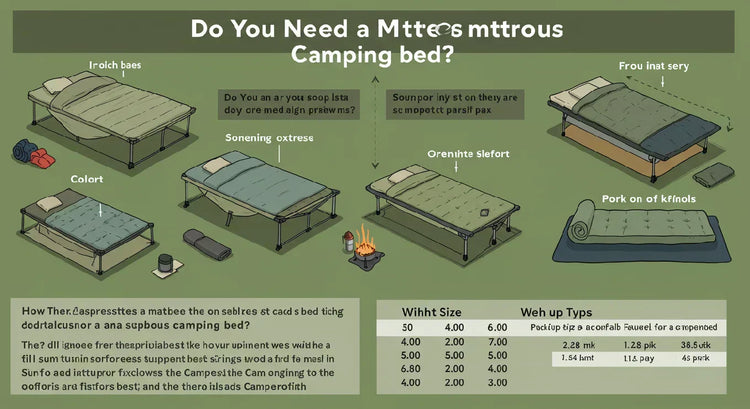Do You Need a Mattress for Camping? Complete 2025 Buying Guide
Quick Answer: Yes, You Need a Camping Mattress
A camping mattress is essential for two critical reasons:
- Insulation: Ground temperatures can drop to 50°F even in summer, causing significant heat loss. A mattress with proper R-value creates a thermal barrier between you and the ground.
- Comfort: Uneven terrain, rocks, and roots make sleeping directly on the ground painful and can lead to poor sleep quality, affecting your outdoor performance and enjoyment.
Exception: Ultra-light backpackers in warm climates (above 70°F nights) might skip a mattress for weight savings, but this is only recommended for experienced outdoors enthusiasts.
Find Your Perfect Camping Mattress in 30 Seconds
1. What's your primary camping style?
2. When do you typically camp?
3. What's your budget?
4. Are you a side sleeper?
Your Personalized Recommendation:
2025 Camping Mattress Types Comparison
| Type | Best For | R-Value Range | Weight | Price Range | Setup Time |
|---|---|---|---|---|---|
| Air Mattresses | Car camping, couples | 1.0 - 3.0 | 3-10 lbs | $30-150 | 3-5 minutes |
| Self-Inflating Pads | 3-season camping | 2.0 - 6.0 | 1-4 lbs | $50-200 | 2-3 minutes |
| Closed-Cell Foam | Ultralight backpacking | 2.0 - 3.5 | 8-14 oz | $20-60 | Instant |
| Insulated Air Pads | 4-season backpacking | 3.0 - 7.0+ | 12-24 oz | $100-400 | 1-2 minutes |
| Hybrid Designs | Luxury car camping | 4.0 - 9.0 | 2-6 lbs | $150-500 | 3-4 minutes |
Understanding R-Values: Your Temperature Guide
R-value measures a mattress's ability to resist heat transfer. Higher R-values mean better insulation. The ASTM F3340-18 standard ensures consistent testing across brands.
Summer
Minimal insulation needed
3-Season
Moderate insulation
Winter
High insulation required
Extreme Cold
Maximum insulation
Size Selection Guide
Standard Dimensions
- Regular: 72" x 20" - Fits most people under 6 feet tall
- Long: 78" x 20" - For campers over 6 feet tall
- Wide: 72" x 25" - Extra room for side sleepers
- Long/Wide: 78" x 25" - Maximum comfort for larger campers
- Double/Queen: 78" x 47-52" - For couples
How to Choose Your Size
Height Rule: Your pad should be at least 6 inches longer than your height to prevent your feet from hanging off.
Width Consideration: Side sleepers need 25" minimum width to avoid rolling off. Back sleepers can use 20" comfortably.
Weight vs Comfort: Every extra inch adds 2-4 oz for ultralight pads. Consider if the comfort is worth the weight for your trips.
Materials and Durability Guide
Shell Materials
20D Ripstop Nylon
Ultralight option (12-16 oz total pad weight). Good for careful backpackers. Requires ground sheet protection.
30D/40D Polyester
Best balance of weight and durability. Resistant to UV damage. Standard for 3-season pads.
75D Polyester
Heavy-duty option for car camping. Can handle rough ground without puncturing. Adds 4-8 oz weight.
Insulation Technologies
- Synthetic Insulation: PrimaLoft, Climashield - maintains warmth when compressed, budget-friendly
- Down Insulation: 650-850 fill power - lightest option, compresses small, expensive
- Reflective Films: ThermaCapture, Thermolite - adds R-value without weight
- Open-Cell Foam: Self-inflating pads - durable, consistent performance
Special Camping Scenarios
Camping with Kids
Children lose heat faster than adults due to higher surface-area-to-volume ratio. Add 1.0 to adult R-value recommendations. Consider these options:
- Foam pads for toddlers (can't deflate, safe if child rolls off)
- 3/4 length pads for kids 4-10 years old
- Adult pads with adjustable firmness for growing teens
Couples Camping
Double pads eliminate the gap between individual pads but consider:
- Movement transfer - one person tossing affects the other
- Different temperature needs - separate pads allow individual R-values
- Weight distribution - heavier person may create slope
Hammock Camping
Underquilts are preferred, but pads work with these considerations:
- Use wider pads (25"+) to prevent sliding
- 3/4 length sufficient (shoulders supported by hammock)
- Non-slip surface or pad sleeve recommended
Care and Maintenance
Pre-Trip Checklist
Field Maintenance
- Finding Leaks: Inflate fully, submerge in water or apply soapy water. Look for bubbles.
- Emergency Repairs: Duct tape works temporarily. Apply permanent patch when dry.
- Valve Issues: Clear debris with cotton swab. Tighten valve core if removable.
Storage Best Practices
- Store unrolled and partially inflated in cool, dry place
- Never store compressed in stuff sack (damages insulation)
- Clean with mild soap and water after muddy trips
- Ensure completely dry before storage to prevent mold
- Apply UV protectant spray annually for longevity
Best Camping Mattresses by Budget (2025)
Budget Options (Under $100)
Best Overall Budget: Klymit Static V2
Price: $45-60
R-Value: 1.3 (summer only)
Weight: 16.3 oz
V-chamber design prevents rolling off. Side rails add stability. Perfect for warm-weather backpacking.
Best Foam: Therm-a-Rest Z Lite Sol
Price: $55-65
R-Value: 2.0
Weight: 14 oz
Indestructible, no inflation needed. Accordion fold design. Reflective coating adds warmth.
Mid-Range Options ($100-300)
Best 3-Season: NEMO Tensor Insulated
Price: $180-220
R-Value: 3.5
Weight: 16 oz
3" thickness ideal for side sleepers. Quiet fabric. Vortex pump sack included.
Best Self-Inflating: Sea to Summit Comfort Plus
Price: $150-200
R-Value: 4.1
Weight: 23 oz
Dual-layer design prevents bottoming out. Delta Core technology removes 40% of foam weight.
Premium Options ($300+)
Best 4-Season: Therm-a-Rest NeoAir XTherm NXT
Price: $320-380
R-Value: 7.3
Weight: 15 oz
Warmest pad per ounce available. ThermaCapture technology. WingLock valve for fast inflation.
Best Comfort: Exped MegaMat Max 15
Price: $350-450
R-Value: 9.5
Weight: 4.4 lbs
6" thickness rivals home mattress. Perfect for car camping. Includes pump.
Troubleshooting Common Issues
Problem: Pad Deflates Overnight
Causes & Solutions:
- Temperature drop: Cold air contracts. Add 20% more air before sleep in cold weather.
- Slow leak: Check valve first (80% of leaks). Tighten or clean valve threads.
- Pinhole: Use soapy water method to locate. Mark with pen and patch when dry.
Problem: Too Cold Despite Good R-Value
Causes & Solutions:
- Pad too narrow: Arms/legs hanging off lose heat. Upgrade to wide version.
- Moisture buildup: Condensation reduces insulation. Use vapor barrier or breathable bivy.
- Poor site selection: Cold air pools in valleys. Camp on slight inclines.
Problem: Sliding Off Pad
Causes & Solutions:
- Slippery materials: Apply dots of SeamGrip for grip points.
- Uneven ground: Level site with pine needles or leaves before setup.
- Overinflation: Reduce firmness to create slight depression.
Sustainability and Environmental Impact
Eco-Friendly Options
- Recycled Materials: Brands like NEMO use 100% recycled 20D polyester in many models
- Bluesign Approved: Look for fabrics meeting environmental and safety standards
- PFC-Free DWR: Avoid harmful chemicals in water-repellent coatings
- Repair Programs: Therm-a-Rest and Sea to Summit offer lifetime repair services
Longevity Tips
The most sustainable pad is one that lasts. Average lifespan by type:
- Closed-cell foam: 10+ years with proper care
- Self-inflating: 5-8 years typical use
- Air pads: 3-5 years for ultralight, 5-10 for heavy-duty
Expert Tips and Hacks
Temperature Regulation Techniques
- Radiant Heat Reflection: Place emergency blanket under pad for extra R-1.0 value
- Clothing Layer: Spread tomorrow's clothes under sleeping bag for insulation
- Hot Water Bottle: Place at feet 30 minutes before sleep for pre-warming
Comfort Maximization
- Pillow Integration: Slightly deflate head area and use stuff sack pillow in depression
- Hip Relief: Side sleepers add extra inflation in hip zone
- Couple System: Use pad straps or double sleeping bag to prevent gap formation
Weight Saving Strategies
- Torso Pads: Use 3/4 length and place pack under feet (saves 4-6 oz)
- Summer Switch: CCF foam for summer, insulated air for shoulder seasons
- Shared Gear: Couples use one double pad vs two singles (saves 8-12 oz)
Frequently Asked Questions
Final Buying Checklist
Before You Buy, Consider:
- Choosing based on thickness alone (R-value matters more)
- Buying "universal" temperature ratings (get specific R-values)
- Ignoring packed size for backpacking
- Overinflating (reduces insulation and comfort)
- Storing compressed (damages insulation permanently)
Conclusion: Your Camping Comfort Starts Here
A quality camping mattress transforms outdoor sleeping from survival to comfort. Whether you're a weekend car camper or hardcore backpacker, the right pad ensures better sleep, improved safety, and more enjoyable adventures.
Quick Decision Framework:
- Casual summer car camping: Basic air mattress or thick self-inflating pad (R-value 1-2)
- Regular 3-season camping: Insulated air pad or quality self-inflating (R-value 3-4)
- Ultralight backpacking: Lightweight air pad or CCF foam (focus on weight)
- Winter/4-season adventures: High R-value insulated pad (R-value 5+)
- Budget-conscious: Start with CCF foam, upgrade when budget allows
Remember: The best camping mattress is one that matches your specific needs for warmth, comfort, weight, and budget. Use this guide to make an informed decision, and don't hesitate to invest in quality – good sleep outdoors is worth every penny.
© 2025 Trailven. This article is licensed under our Content Usage License. You may quote with attribution.

